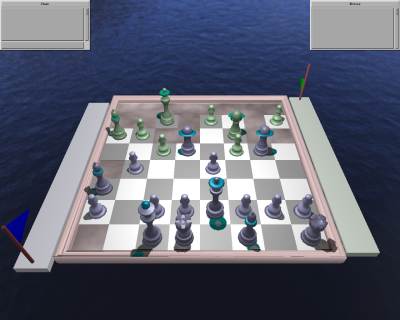Fog of War Chess
by William Lee Sims
Introduction
This is a computer-only variation of chess originally conceptualized by Cameron Hendricks and filled out and implemented by myself. A link to download the application is provided in Computer Play.The general concept is that regular chess is played, but you can only see the places where you pieces can move and attack. There are a few exceptions to this, further detailed in the rules.
Setup
The board is setup according to the standard rules of chess. One exception is that I use green and blue pieces instead of the tradition black and white. It obviously has no affect, but it has been known to throw a few people off guard.Pieces
The pieces are identical to those found in the standard rules of chess.Rules
-
Concept
- Play chess in the same way, but you can only see where you can move.
-
Movement
- Pieces move as they always have in chess.
- The places you can move by the rules will be visible. (See the visibility rules and their exceptions.)
- The places you can move are marked with yellow discs. The places you can capture are marked with red discs.
-
Visibility
-
All pieces see the square they are on, the squares they can move to, the squares they can capture, and (most importantly) the squares of friendlies who are "blocking" it. This last part matters most for capturing.
-
Exceptions
- Pawns see the three squares in front of them at all times.
- The king has a warning system. The squares around him and the square he is on will be marked with red boxes if the king cannot move there.
- If the king is in check, the pieces that could capture him are also visible.
-
If a piece cannot move a certain direction because its movement will put the king in jeopardy, the positions will still be visible.
- For example, a rook that is between your king and the opponents queen will still see in the directions that would otherwise be illegal movements.
- The square will also be marked with a purple box to signify that its moves have been altered.
-
Exceptions
-
All pieces see the square they are on, the squares they can move to, the squares they can capture, and (most importantly) the squares of friendlies who are "blocking" it. This last part matters most for capturing.
-
Capturing
- Pieces move as they always have in chess.
-
When you capture a piece, you will gain visibility to all of the squares that the captured piece could see.
- See visibility rules for more clarification on what these will be.
- This will last until you next turn ends, so document any new information you find as soon as possible.
-
End Game
-
When one player only has a king and the other player has one of the following conditions, the game will be listed as a draw:
- King
- King and one Knight
- King and any number of Bishops on the same color square.
-
The game can also be ended early by two commands:
- Both players type '/draw' in the chat window (without the quotes).
- One player types '/surrender' in the chat window (without the quotes).
-
When one player only has a king and the other player has one of the following conditions, the game will be listed as a draw:

-
Visual Clues
- White or silver squares - Visibilities
- Dark red squares with fog over them - Parts of the board you cannot see
- Red box - Movement of the king there would cause a check or mate.
- Purple box - Movement of that piece has been limited due to checkmate conditions.
- Yellow disc - Where the currently selected piece can move.
- Red disc - Where the currently selected piece can capture.
- Blue flag up - Blue player's turn.
- Green flag up - Green player's turn.
Notes
Click the info button in the game to learn how to find other players playing. Since this game has not (will not?) reached critical mass, you will probably need to have found somebody in advance to play against.You can also read the rules at my web site.
